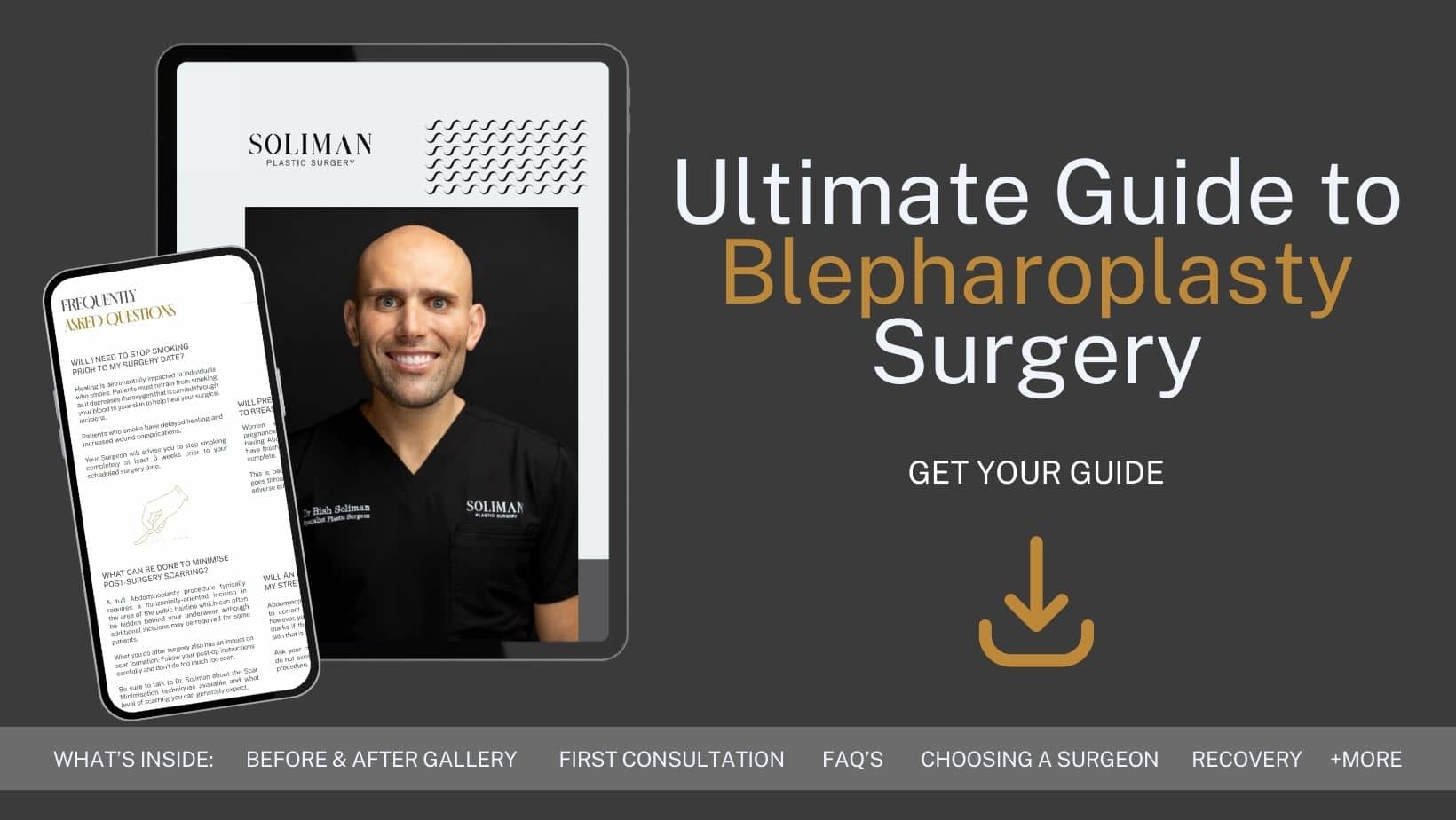How Drooping Eyelids Impact Vision- Causes and Effects of Eyelid Ptosis
The eyes are not just the windows to the soul; they are also essential tools that navigate you through the complexities of the world. When your eyelids begin to droop, it may start as a subtle change, but it can gradually lead to serious vision impairment. It’s important to understand this condition, as early detection and treatment can make all the difference.
As you age, your body undergoes various changes, and your eyes are no exception. Drooping eyelids are often associated with ageing, but they can also occur due to other factors. When you hear the term ‘drooping eyelids’, you might think of it as a cosmetic concern. However, what you may not realise is that drooping eyelids, medically known as ptosis, can have a significant impact on your vision and overall eye health. The condition can range from being barely noticeable to severe, where it can cover the pupil entirely.
In this blog, Sydney Specialist Plastic Surgeon Dr Bish Soliman will explore the anatomy of the eye, the causes of drooping eyelids, their implications on your daily life, and the medical solutions available.
Download Dr Bish Soliman Blepharoplasty Guide

The Anatomy of the Eye and Eyelids
To grasp how drooping eyelids can affect your vision, you must first understand the anatomy of the eye and its surrounding structures. Your eye is a complex organ, protected by the eyelids, which serve several vital functions. The upper and lower eyelids are designed to move freely and smoothly, safeguarding the eye from debris, distributing tears, and regulating light entry.
The levator palpebrae superioris muscle is primarily responsible for lifting the upper eyelid. This muscle, along with the surrounding tissues and skin, can weaken or become damaged over time, leading to a drooping appearance. These structures work in harmony to ensure your eyelids can open and close without hindrance, a function that is easy to take for granted until problems arise.
The eyelids also contain a thin layer of skin, the thinnest in the body, which is highly sensitive and susceptible to changes. Beneath this skin lies a complex network of muscles, nerves, and connective tissues, all of which play a role in maintaining the position and function of your eyelids. Any disruption to these components can lead to issues such as ptosis, which in turn can affect your vision.
What Causes Drooping Eyelids?
The causes of drooping eyelids are as varied as the individuals who experience them. One of the most common reasons is the natural ageing process. As you age, the muscles that support your eyelids weaken, and the skin around your eyes loses elasticity, leading to a droopy appearance. This type of ptosis can occur gradually and might not be noticed until it starts to obscure your vision.
Apart from ageing, several other factors can lead to drooping eyelids. Certain medical conditions, such as diabetes, stroke, or tumours, can affect the muscles or nerves associated with eyelid function. Trauma or injury to the eye or eyelid can also result in ptosis, as can complications from eye surgery. Even some medications, particularly those that affect muscle function or nerve responses, can cause temporary or permanent eyelid drooping.
In some cases, drooping eyelids can be congenital, meaning that some individuals are born with the condition. Children with congenital ptosis may require early medical intervention to prevent developmental issues with their vision. Regardless of the cause, understanding why drooping eyelids occur is crucial for determining the best course of action for treatment.
How Do Drooping Eyelids Affect Eyesight?
Drooping eyelids can have a noticeable impact on your vision. When the upper eyelid sags, it can partially or, in severe cases, completely cover the pupil. This obstruction can reduce your field of vision, making it difficult to see objects, especially those above you or in your peripheral vision. This impairment can be particularly bothersome when performing tasks that require a full range of vision, such as driving or reading.
Moreover, when you have ptosis, you might unconsciously tilt your head back or raise your eyebrows to lift the drooping eyelids and clear your line of sight. These compensatory actions can lead to headaches, neck pain, and fatigue due to the constant strain on your muscles. Over time, the effort to maintain clear vision can also cause eye strain and discomfort.
Furthermore, drooping eyelids can affect the symmetry of your eyes, which can lead to a condition known as astigmatism. This refractive error causes blurred vision because the irregular shape of your eyelids alters the way light enters your eye. In children, untreated ptosis can lead to amblyopia, or lazy eye, which can cause permanent vision loss if not addressed promptly.
Implications of Drooping Eyelids on Daily Life
The implications of drooping eyelids on your daily life can be quite profound. Simple tasks that you may have taken for granted can become challenging. For instance, you might find it difficult to keep your eyes open while reading, working on the computer, or watching television. This can lead to a decrease in productivity and enjoyment of leisure activities.
The visual impairment caused by ptosis can also compromise your safety. Activities that require sharp vision, such as driving, can become hazardous if your drooping eyelids limit your field of vision. The inability to fully see traffic lights, signs, or oncoming vehicles can increase the risk of accidents. Similarly, your balance and spatial awareness may be affected, making you more prone to falls and injuries.
Age and its Correlation with Drooping Eyelids
Age is one of the primary factors associated with drooping eyelids. As part of the natural ageing process, the tissues around your eyes, including your muscles and skin, lose their elasticity and strength. This results in a gradual descent of the eyelid, which can eventually interfere with your vision. Age-related changes in the eyelids are not just cosmetic issues; they can have real implications for your eye health.
The correlation between age and drooping eyelids is well documented, and most people will experience some degree of ptosis as they grow older. Genetics can also play a role in how soon and to what extent your eyelids will droop. Some individuals may notice changes as early as their 30s or 40s, while others might not experience significant drooping until later in life.
Preventative measures, such as protecting your eyes from sun damage, maintaining a healthy lifestyle, and treating any underlying health conditions, can help slow the progression of ptosis. However, the inevitability of ageing means that most people will need to address drooping eyelids at some point. Fortunately, there are effective medical solutions available.
Treatment for Drooping Eyelids – Medical Solutions
When it comes to addressing drooping eyelids, there are several solutions that can restore both function and appearance. The most common treatment for ptosis is blepharoplasty, a surgical procedure that involves removing excess skin, muscle, and sometimes fat from the upper eyelids. This surgery can significantly improve your field of vision and give you a more alert appearance.
For those who are not candidates for surgery or prefer a less invasive approach, there are other treatments available. Neuromodulator injections can temporarily lift the eyelids by relaxing the muscles that pull them down. There are also eye drops that can stimulate the levator muscle, providing a short-term lift to the eyelid. These options can be an alternative for individuals with mild ptosis or those seeking temporary relief.
FAQs about Drooping Eyelids
How do you get rid of droopy eyelids?
- To alleviate droopy eyelids, several treatments are available, ranging from non-surgical options like eyelid exercises, special tapes or makeup techniques that create the illusion of tighter skin, to more permanent solutions such as blepharoplasty (eyelid surgery). The choice of treatment depends on the severity of the droopiness and the underlying cause. Non-invasive procedures such as neuromodulator injections can also temporarily improve the appearance of droopy eyelids by lifting the surrounding area. Consultation with Dr Bish Soliman is essential to determine the most appropriate approach for each individual case.
What causes a droopy eyelid?
- Droopy eyelids, or ptosis, can be caused by a variety of factors, including ageing, genetics, trauma, or certain medical conditions. As people age, the skin loses elasticity and the muscles supporting the eyelids weaken, leading to sagging. Inherited traits can also predispose individuals to this condition. Trauma or surgery around the eye area can damage the muscles or nerves controlling eyelid movement, resulting in droopiness. Additionally, medical conditions such as myasthenia gravis, which affects muscle strength, or neurological disorders can lead to ptosis.
Can stress cause eye droop?
- While stress itself is not a direct cause of eye droop (ptosis), the physical and emotional effects of prolonged stress can exacerbate underlying conditions that might contribute to eyelid issues. Stress can lead to habits such as rubbing the eyes excessively, which in turn can cause mechanical stretching and weakening of the eyelid muscles and skin. Moreover, stress-related conditions can indirectly affect the skin’s elasticity and muscle tone around the eyes. Managing stress through relaxation techniques, adequate sleep, and a healthy lifestyle can help mitigate its indirect effects on eyelid health.
What are the most common eyelid problems?
- The most common eyelid problems include ptosis (droopy eyelids), blepharitis (inflammation of the eyelids), chalazion (a blockage in one of the small oil glands at the margin of the eyelid), styes (painful, red lumps near the edge of the eyelid), and ectropion or entropion (where the eyelid turns outward or inward, respectively). These conditions can lead to discomfort, impaired vision, and aesthetic concerns. Factors such as ageing, infections, allergies, and certain skin disorders can contribute to the development of these eyelid issues.
Is it painful to get eyelid surgery?
- Eyelid surgery, or blepharoplasty, is generally performed under local anaesthesia with sedation, which means patients are awake but relaxed, and the area around the eyes is numbed. Post-operative discomfort is usually mild and can include swelling, bruising, and a tight or sore feeling around the eyes, which can be managed with prescribed pain relief medications. Recovery times vary, but many patients can return to normal activities within a week or two, following Dr Soliman’s advice on care and healing.
Further Reading about Eyelid Surgery with Sydney Plastic Surgeon Dr Bish Soliman
- Read Dr Bish Soliman’s Will Medicare Cover My Eyelid Surgery Blog
- Read Dr Bish Soliman’s FAQs about Upper Blepharoplasty Surgery (Upper Eyelids) Blog
- Read Dr Bish Soliman’s Tips to Reduce Swelling and Bruising After Eyelid Surgery Blog
- Read Dr Bish Soliman’s Recovery after Eyelid Surgery Blog
- Read Dr Bish Soliman’s Preparing For Upper Blepharoplasty Surgery Performed in Rooms Blog
Medical References about Drooping Eyelids
- Ptosis (Droopy Eyelid): Causes & Treatment – Cleveland Clinic
- Droopy Eyelid (Ptosis): 5 Causes of Drooping Eyelids – WebMD
- Reasons for Droopy Eyelids – WebMD
- Droopy eyelid (ptosis): Causes, risk factors, and treatment – Medical News Today
- How To Fix Droopy Eyelids, Circles and Sags – Cleveland Clinic



